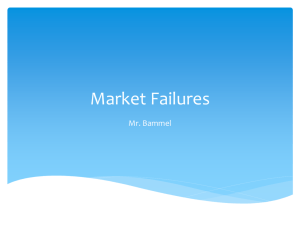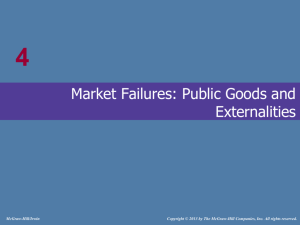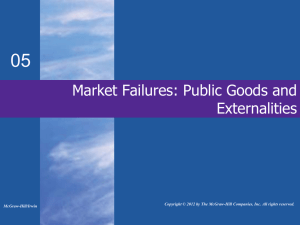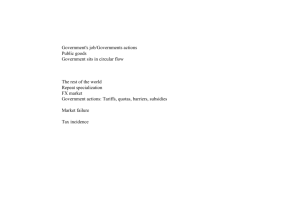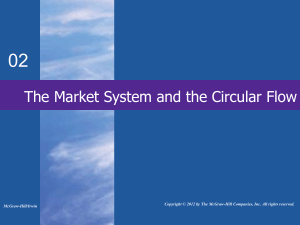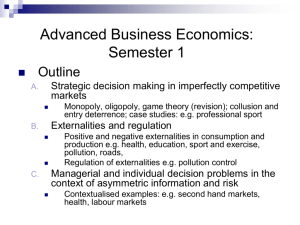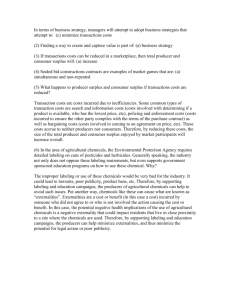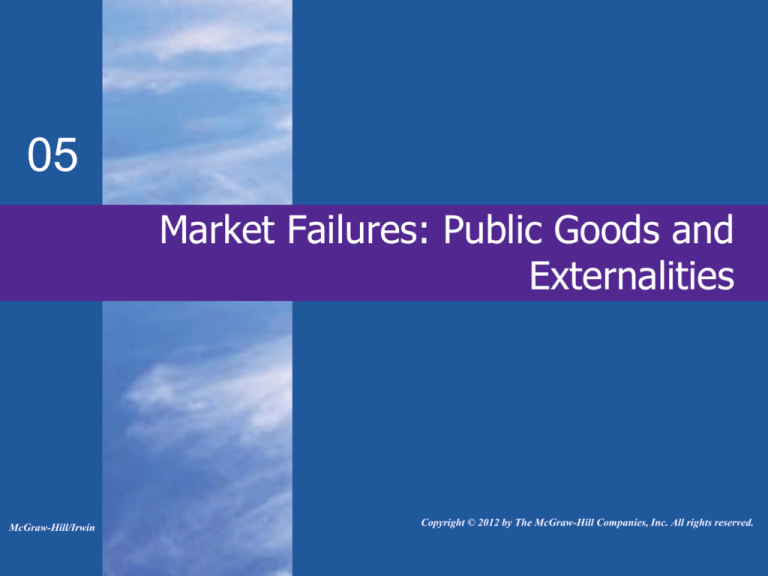
05
Market Failures: Public Goods and
Externalities
McGraw-Hill/Irwin
Copyright © 2012 by The McGraw-Hill Companies, Inc. All rights reserved.
Market Failures
• Market fails to produce the right
•
LO1
amount of the product
Resources may be
• Over-allocated
• Under-allocated
5-2
Demand-Side Failures
• Impossible to charge consumers
what they are willing to pay for the
product
• Some can enjoy benefits without
paying
LO1
5-3
Supply-Side Failures
• Occurs when a firm does not pay
the full cost of producing its output
• External costs of producing the
good are not reflected in the supply
LO1
5-4
Efficiently Functioning Markets
• Demand curve must reflect the
•
LO1
consumers full willingness to pay
Supply curve must reflect all the costs
of production
5-5
Consumer Surplus
• Difference between what a consumer
•
LO2
is willing to pay for a good and what
the consumer actually pays
Extra benefit from paying less than
the maximum price
5-6
Price (per bag)
Consumer Surplus
Consumer
Surplus
Equilibrium
Price
P1
D
Q1
Quantity (bags)
LO2
5-7
Producer Surplus
• Difference between the actual price a
•
LO2
producer receives and the minimum
price they would accept
Extra benefit from receiving a higher
price
5-8
Price (per bag)
Producer Surplus
Producer
surplus
S
P1
Equilibrium
price
Q1
Quantity (bags)
LO2
5-9
Efficiency Revisited
Price (per bag)
Consumer
surplus
S
P1
Producer
surplus
D
Q1
Quantity (bags)
LO2
5-10
Efficiency Losses
Price (per bag)
a
Efficiency loss
from underproduction
S
d
b
e
D
c
Q2 Q1
Quantity (bags)
LO2
5-11
Efficiency Losses
Price (per bag)
a
Efficiency loss
from overproduction
S
f
b
g
D
c
Q1 Q3
Quantity (bags)
LO2
5-12
Private Goods
• Produced in the market by firms
• Offered for sale
• Characteristics
• Rivalry
• Excludability
LO3
5-13
Public Goods
• Provided by government
• Offered for free
• Characteristics
• Nonrivalry
• Nonexcludability
• Free-rider problem
LO3
5-14
Cost-Benefit Analysis
• Cost
• Resources diverted from private
•
LO3
good production
• Private goods that will not be
produced
Benefit
• The extra satisfaction from the
output of more public goods
5-15
Externalities
• A cost or benefit accruing to a third
•
•
LO4
party external to the transaction
Positive externalities
• Too little is produced
• Demand-side market failures
Negative externalities
• Too much is produced
• Supply side market failures
5-16
Government Intervention
• Correct negative externalities
• Direct controls
• Specific taxes
• Correct positive externalities
• Subsidies
• Government provision
LO4
5-17
Government Intervention
P
Negative
externalities
a
b
P
St
St
a
S
T
c
0
LO4
S
D
Overallocation
Qo Qe
Q
D
0
Qo Qe
Q
(a)
(b)
Negative externalities
Correct externality with
tax
5-18
Government Intervention
Methods for Dealing with Externalities
Problem
Resource Allocation
Outcome
Ways to Correct
Negative externalities
(spillover costs)
Overproduction of output
and therefore
overallocation of
resources
1.
2.
3.
4.
5.
Private bargaining
Liability rules and lawsuits
Tax on producers
Direct controls
Market for externality rights
Positive externalities
(spillover benefits)
Underproduction of output
and therefore
underallocation of
resources
1.
2.
3.
4.
Private bargaining
Subsidy to consumers
Subsidy to producers
Government provision
LO4
5-19
Government’s Role in the Economy
• Government can have a role in
•
•
LO5
correcting externalities
Officials must correctly identify the
existence and cause
Has to be done in the context of
politics
5-20



